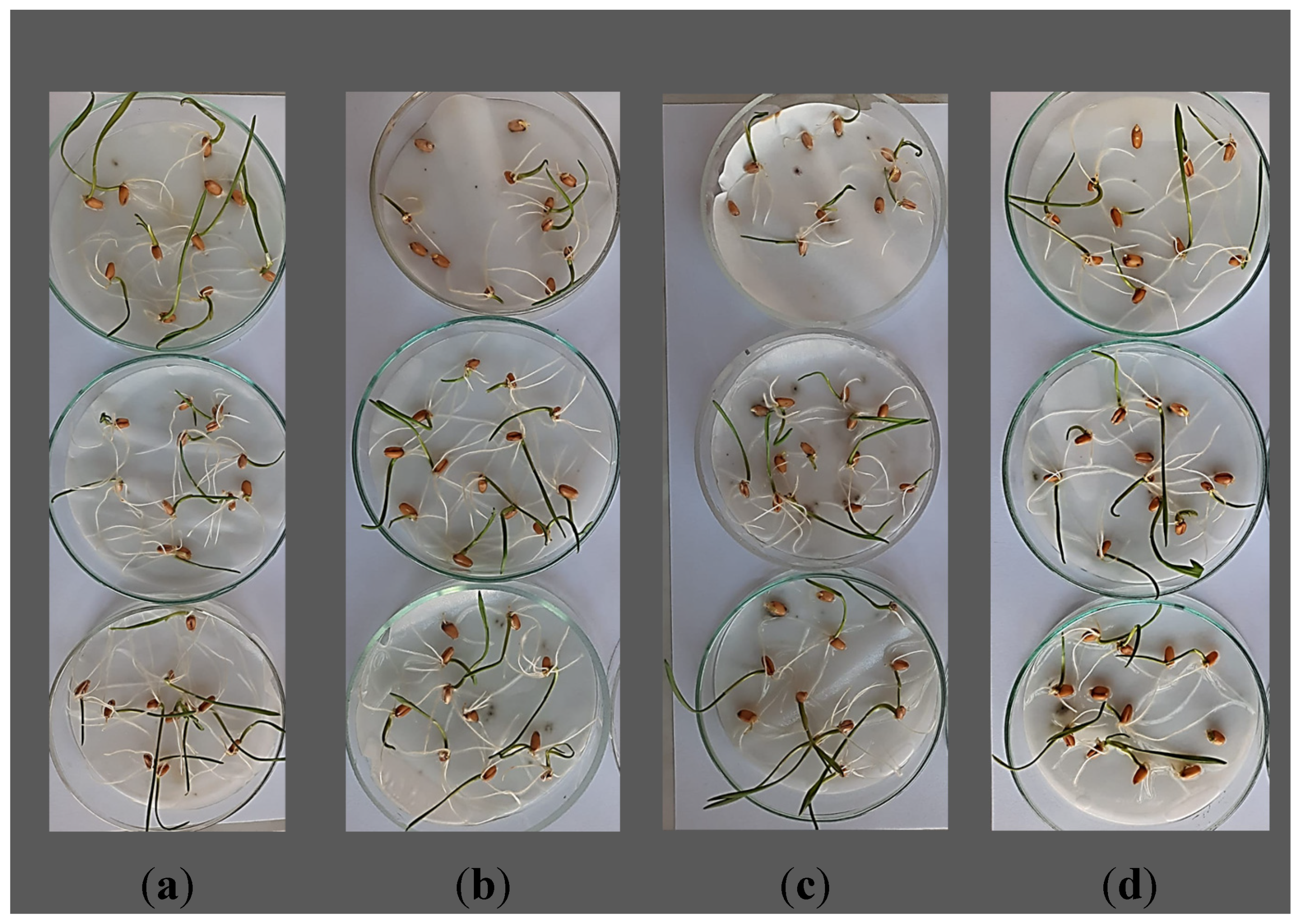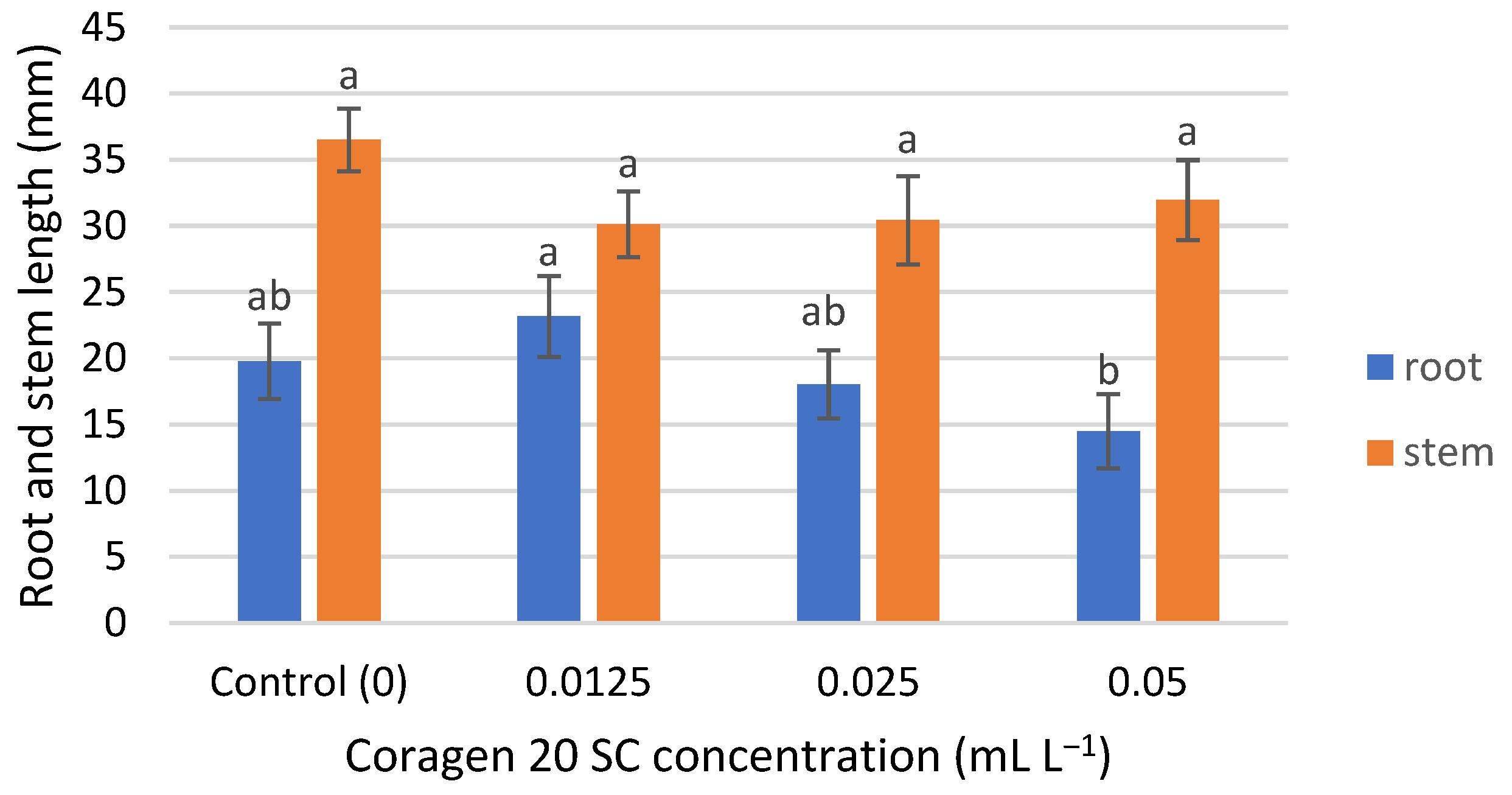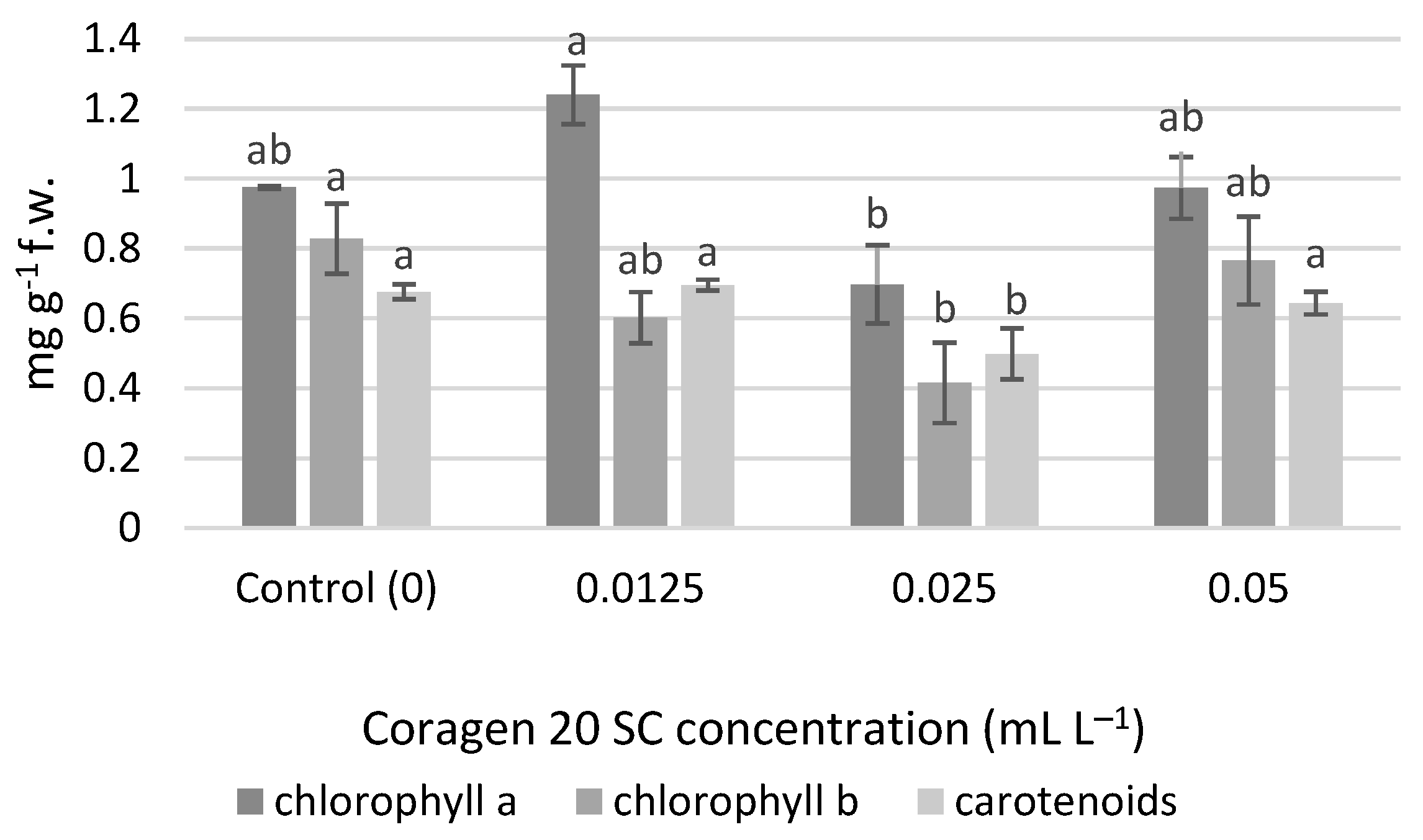Evaluation of the Morphological, Physiological and Biochemical Effects Induced by Coragen 20 SC in Some Non-Target Species
Abstract
1. Introduction
2. Materials and Methods
2.1. The Evaluation of Coragen-Induced Toxicity on Fish
2.2. The Evaluation of Coragen-Induced Phytotoxicity
3. Results and Discussion
3.1. Influence of Coragen 20 SC on Perca Fluviatilis (Linné, 1758)
3.1.1. Effects on Oxygen Consumption and Respiratory Rate
3.1.2. Effects on Hematological Parameters, Glucose, and Behavioral Changes
3.2. Influence of Coragen 20 SC on Triticum aestivum Seedling Growth and Weight
3.3. Influence of Coragen 20 SC on Photosynthetic Pigments
4. Conclusions
Author Contributions
Funding
Institutional Review Board Statement
Informed Consent Statement
Data Availability Statement
Acknowledgments
Conflicts of Interest
References
- Grant, I.F. Insecticides for tsetse and trypanosomiasis control: Is the environmental risk acceptable? Trends Parasitol. 2001, 17, 10–14. [Google Scholar] [CrossRef]
- Sáez-Gómez, P.; Prenda, J. Freshwater Fish Biodiversity in a Large Mediterranean Basin (Guadalquivir River, S Spain): Patterns, Threats, Status and Conservation. Diversity 2022, 14, 831. [Google Scholar] [CrossRef]
- Lavtižar, V. Environmental Stability and Toxicity Assessment of Chlorantraniliprole and Its Derivatives. Ph.D. Thesis, University of Nova Gorica, Graduate School, Rožna Dolina, Slovenia, 2015. [Google Scholar]
- Lahm, G.P.; Cordova, D.; Barry, J.D. New and selective ryanodine receptor activators for insect control. Bioorg. Med. Chem. 2009, 17, 4127–4133. [Google Scholar] [CrossRef] [PubMed]
- Bassi, A.; Rison, J.L.; Wiles, J.A. Chlorantraniliprole (dpx-e2y45, Rynaxypyr®, Coragen®), a new diamide insecticide for control of codling moth (Cydia pomonella), colorado potato beetle (Leptinotarsa decemlineata) and european grapevine moth (Lobesia botrana). In Proceedings of the 9th Slovenian Conference on Plant Protection, Nova Gorica, Slovenia, 4–5 March 2009. [Google Scholar]
- DuPont. Altacor® & Coragen® Now Registered for Use on More Crops. 10 May 2011. Available online: http://www.dupont.ca/content/ca/en_ca/products-and-services/crop-protection/vegetable-protection/press-releases/altacor-coragen.html (accessed on 22 September 2022).
- NPIC Product Research Online (NPRO): Chlorantraniliprole; National Pesticide Information Center: Corvallis, OR, USA, 2021. Available online: http://npic.orst.edu/factsheets/chlorantraniliprole.html (accessed on 27 February 2023).
- Teixeira, L.A.; Andaloro, J.T. Diamide insecticides: Global efforts to address insect resistance stewardship challenges. Pestic. Biochem. Physiol. 2013, 106, 76–78. [Google Scholar] [CrossRef]
- Lahm, G.P.; Stevenson, T.M.; Selby, T.P.; Freudenberger, J.H.; Cordova, D.; Flexner, L.; Bellin, C.A.; Dubas, C.M.; Smith, B.K.; Hughes, K.A.; et al. Rynaxypyr: A new insecticidal anthranilic diamide that acts as a potent and selective ryanodine receptor activator. Bioorg. Med. Chem. Lett. 2007, 17, 6274–6279. [Google Scholar] [CrossRef]
- Ogawa, Y.; Kurebayashi, N.; Murayama, T. Ryanodine receptor isoforms in excitation-contraction coupling. Adv. Biophys. 1999, 36, 27–64. [Google Scholar] [CrossRef]
- Fan, Y.; Xu, C.; Miao, W. DNA Damage in Liver Cells of the Tilapia Fish Oreochromis mossambicus Larva Induced by the Insecticide Cyantraniliprole at Sublethal Doses During Chronic Exposure. Methods Mol. Biol. 2021, 2326, 203–214. [Google Scholar] [CrossRef]
- USEPA—Chlorantraniliprole: Problem Formulation for Registration Review. 2020. Available online: https://www.regulations.gov/document/EPA-HQ-OPP-2020-0034-0009 (accessed on 27 February 2023).
- Li, X.; Tu, M.; Yang, B.; Zhang, Q.; Li, H.; Ma, W. Chlorantraniliprole in foods: Determination, dissipation and decontamination. Food Chem. 2023, 406, 135030. [Google Scholar] [CrossRef]
- Australian Pesticides and Veterinary Medicines Authority, JUNE 2008. Evaluation of the New Active Chlorantraniliprole in the Products DUPONT CORAGEN INSECTICIDE DUPONT ALTACOR INSECTICIDE DUPONT ACELEPRYN INSECTICIDE. Available online: https://apvma.gov.au/sites/default/files/publication/13651-prs-chlorantraniliprole.pdf (accessed on 27 February 2023).
- Food and Agriculture Organisation (FAO). Pesticide Report, Chlorantraniliprole. 2008. Available online: http://www.fao.org/fileadmin/templates/agphome/documents/Pests_Pesticides/JMPR/Evaluation08/Chlorantraniliprole.pdf (accessed on 5 July 2023).
- Risk Assessment of the Pesticide Coragen 20 SC with the Active Substance Chlorantraniliprole. Opinion of the Panel on Pesticides, Norwegian Scientific Committee for Food Safety 29th of June, VKM Report 2010: 21. 2010. Available online: https://vkm.no/download/18.a665c1015c865cc85be070f/1500469190826/58a916e5c9.pdf (accessed on 27 February 2023).
- Safety Data Sheet Coragen MaX Insecticide. 2022. Available online: https://www.cdms.net/ldat/mpH07008.pdf (accessed on 27 February 2023).
- Cheng, C.; Hu, J. Residue levels of chlorantraniliprole and clothianidin in rice and sugar cane and chronic dietary risk assessment for different populations. Microchem. J. 2022, 183, 107936. [Google Scholar] [CrossRef]
- PubChem; National Center for Biotechnology Information; National Library of Medicine; National Institutes of Health. Chlorantraniliprole Compound Summary; Chlorantraniliprole, C18H14BrCl2N5O2—PubChem (nih.gov); 2021. Available online: https://pubchem.ncbi.nlm.nih.gov/compound/Chlorantraniliprole (accessed on 27 February 2023).
- Kandil, M.A.-H.; Sammour, E.A.; Abdel-Aziz, N.F.; Agamy, E.A.E.M.; El-Bakry, A.M.; Abdelmaksoud, N.M. Comparative toxicity of new insecticides generations against tomato leafminer Tuta absoluta and their biochemical effects on tomato plants. Bull. Natl. Res. Cent. 2020, 44, 126. [Google Scholar] [CrossRef]
- Overview of Freshwater and Marine Toxicity Tests: A Tool for Ecological Risk Assessment. Available online: https://oehha.ca.gov/media/downloads/ecotoxicology/general-info/marinetox3.pdf (accessed on 27 February 2023).
- Chlorantraniliprole Pesticide Fact Sheet; US Environmental Protection Agency, Office of Prevention, Pesticides and Toxic Substances, U.S. Government Printing Office. 2008. Available online: https://www3.epa.gov/pesticides/chem_search/reg_actions/registration/fs_PC-090100_01-Apr-08.pdf (accessed on 27 February 2023).
- Chlorantraniliprole: Problem Formulation for Registration Review; US Environmental Protection Agency, Office of Chemical Safety and Pollution Prevention, U.S. Government Printing Office. 2019. Available online: https://www.federalregister.gov/documents/2019/10/07/2019-21541/chlorantraniliprole-pesticide-tolerances (accessed on 27 February 2023).
- FMC, Safety Data Sheet Coragen® insecticide 2023. Available online: https://www.fmccrop.com.au/download/coragen_au_6n_0123.pdf (accessed on 27 February 2023).
- Drăghiceanu, O.A.; Fierăscu, I.; Fierăscu, R.C.; Bradzis, R.; Dobrescu, C.M.; Soare, L.C. Considerations regarding the Triticum phytotoxycity test. Curr. Trends Nat. Sci. 2019, 8, 48–55. [Google Scholar]
- Jităreanu, A.; Caba, I.-C.; Trifan, A.; Pădureanu, S.; Agoroaei, L. Triticum aestivum Assay—A Useful Tool for Environmental Monitoring and Toxicity Assessment. Not. Bot. Horti Agrobot. Cluj-Napoca 2019, 47, 1005–1018. [Google Scholar] [CrossRef]
- Muñoz-Ortuño, M.; Serra-Mora, P.; Herráez-Hernández, R.; Verdú-Andrés, J.; Campíns-Falcó, P. A new tool for direct non-invasive evaluation of chlorophyll a content from diffuse reflectance measurements. Sci. Total Environ. 2017, 609, 370–376. [Google Scholar] [CrossRef]
- Gautam, H.; Singh, S.; Prashad, H.; Kumar, A.M.; Choudhary, A.; Kaur, H.; Narayan, O.P.; Lal, S.K.; Mehta, S. Chapter 12—Pesticide toxicity and their impact on plant growth, active constituents and productivity. In Plants and Their Interaction to Environmental Pollution; Elsevier: Amsterdam, The Netherlands, 2023; pp. 231–252. [Google Scholar] [CrossRef]
- Rajak, P.; Roy, S.; Ganguly, A.; Mandi, M.; Dutta, A.; Das, K.; Nanda, S.; Ghanty, S.; Biswas, G. Agricultural pesticides—Friends or foes to biosphere? J. Hazard. Mater. Adv. 2023, 10, 100264. [Google Scholar] [CrossRef]
- Drăghiceanu, O.A.; Soare, L.C.; Șuțan, A.N.; Fierascu, I.; Fierascu, R.C.; Dobrescu, C.M. The use of Triticum test in the evaluation of the materials’ phytotoxicity. In Development of Plant Extracts and Innovative Phytosynthesized Nanostructures Mixtures with Phytotherapeutic Applications, in Order to Reduce Biocenotic Stress in Horticultural Crops; Fierăscu, I., Fierăscu, R.C., Soare, L.C., Eds.; Ruse Press: Ruse, Bulgaria, 2021; pp. 87–116. [Google Scholar]
- OECD. Guideline for Testing Chemicals 208. Terrestrial Plant Test: Seedling Emergence and Seedling Growth Test. 2006, F0. Available online: https://www.oecd-ilibrary.org/docserver/9789264070066-en.pdf?expires=1678614262&id=id&accname=guest&checksum=BCF9BBEAE24D9829FFCDE9E5E688BEF0 (accessed on 12 March 2023). [CrossRef]
- Pszczolińska, K.; Perkons, I.; Bartkevics, V.; Drzewiecki, S.; Płonka, J.; Shakeel, N.; Barchanska, H. Targeted and non-targeted analysis for the investigation of pesticides influence on wheat cultivated under field conditions. Environ. Poll. 2023, 316, 120468. [Google Scholar] [CrossRef]
- Picoş, C.A.; Năstăsescu, G.H. Lucrări Practice de Fiziologie Animală; Tipografia Universităţii din Bucureşti: Bucharest, Romania, 1988; 107, 122–123, 192–195. [Google Scholar]
- Brønstad, A. Good anesthesia practice for fish and other aquatics. Biology 2022, 11, 1355. [Google Scholar] [CrossRef]
- Holm, G. Chlorophyll mutations in barley. Acta Agric. Scand. 1954, 4, 457–471. [Google Scholar] [CrossRef]
- Ma, C.; He, M.; Zhong, Q.; Ouyang, W.; Lin, C.; Liu, X. Uptake, translocation and phytotoxicity of antimonite in wheat (Triticum aestivum). Sci. Total Environ. 2019, 669, 421–430. [Google Scholar] [CrossRef] [PubMed]
- Scott, G.R.; Sloman, K.A. The effects of environmental pollutants on complex fish behaviour: Integrating behavioural and physiological indicators of toxicity. Aquat. Toxicol. 2004, 68, 369–392. [Google Scholar] [CrossRef] [PubMed]
- Venkata Rathnamma, V.; Nagaraju, B. Acute toxicity and Histopathological changes in freshwater fish Cirrhinus mrigala exposed to chlorantraniliprole. J. Zool. Stud. 2014, 1, 23–30. [Google Scholar]
- Venkata Rathnamma, V.; Nagaraju, B. Median Lethal Concentrations (LC50) of Chlorantraniliprole and Its Effects on Behavioral Changes in Freshwater Fish Labeo Rohita. Int. J. Public Health Sci. 2013, 2, 137–142. [Google Scholar] [CrossRef]
- Sinha, B.K.; Gour, J.K.; Singh, M.K.; Nigam, A.K. Effects of Pesticides on Haematological Parameters of Fish: Recent Updates. J. Sci. Res. 2022, 66, 269–283. [Google Scholar] [CrossRef]
- Pimpao, C.T.; Zampronio, A.R.; De Assis, H.S. Effects of deltamethrin on hematological parameters and enzymatic activity in Ancistrus multispinis (Pisces, Teleostei). Pesticide Biochem. Physiol. 2007, 88, 122–127. [Google Scholar] [CrossRef]
- Ali, H.A.; Rani, V.J. Effect of phosalone on haematological indices in the tilapia, Oreochromis mossambicus. Turkish J. Vet. Anim. Sci. 2009, 33, 407–411. [Google Scholar] [CrossRef]
- Ferrando, M.D.; Andreu-Moliner, E. Lindane induced changes in carbohydrate metabolism in Anguilla anguilla. Comp. Biochem. Physiol. 1992, 74B, 750–799. [Google Scholar] [CrossRef] [PubMed]
- Kavitha, C.; Malarvizhi, A.; Senthil Kumaran, S.; Ramesh, M. Toxicological effects of arsenate exposure on hematological, biochemical and liver transaminases activity in an Indian major carp, Catla catla. Food Chem. Toxicol. 2010, 48, 2848–2854. [Google Scholar] [CrossRef]
- Dutta, K.; Ali, M.; Najam, A.; Kumar, R.; Kumar, A. Ameliorative effect of seed extract of Pterocarpus santalinus on coragen induced haematological alterations and serum biochemical changes in Charles Foster rats. J. Toxicol. Environ. Health Sci. 2014, 6, 194–202. [Google Scholar]
- Shallan Magdy, A.; Abdel-Mobdy Yasmin, E.; Hamdi, E.; Abdel Rahim Emam, A. Coragen (Chlorantraniliprole) insecticide effects on male albino rats. Res. J. Pharm. Biol. Chem. Sci. 2016, 7, 1536–1545. [Google Scholar]
- Fournier, M.; Cyr, D.; Blakley, B.; Boermans, H.; Brousseau, P. Phagocytosis as a biomarker of immunotoxicity in wildlife species exposed to environmental xenobiotics. Am. Zool. 2000, 40, 412–420. [Google Scholar] [CrossRef]
- Sahoo, S.; Banu, H.; Prakash, A.; Tripathi, G. Immune system of fish: An evolutionary perspective. In Antimicrobial Immune Response; del Mar Ortega-Villaizan, M., Chico, V., Eds.; IntechOpen: London, UK, 2021. [Google Scholar] [CrossRef]
- Cestonaro, L.V.; Macedo, S.M.D.; Piton, V.Y.; Garcia, S.C.; Arbo, M.D. Toxic effects of pesticides on cellular and humoral immunity: An overview. Immunopharmacol. Immunotoxicol. 2022, 44, 816–831. [Google Scholar] [CrossRef]
- Nagaraju, B.; Venkata Rathnamma, V. Fluctuations of certain Biochemical constituents as a consequence of Chlorantraniliprole toxicity in the Mud Fish, Channa punctatus (Bloch, 1974). J. Zool. Res. 2018, 2, 11–16. [Google Scholar]
- Nagaraju, B.; Venkata Rathnamma, V. Acute toxicity of chlorantraniliprole to freshwater fish Channa punctatus (Bloch). Adv. Zool. Bot. 2013, 1, 78–82. [Google Scholar] [CrossRef]
- Jixiang, C.; Weili, Y.; Guangyou, W.; Lei, S.; Chengcai, W.; Lixia, L.; Xiaoman, L.; Pei, W. Acute Toxicity and Safety Evaluation of Chlorantraniliprole to Environmental Organisms. Asian J. Ecotoxicol. 2022, 6, 452–461. [Google Scholar]
- Fan, T.; Chen, X.; Zhao, M.; Wang, J.; Meng, Z.; Dong, S.; Miao, X.; Wu, Q. Uptake, translocation and subcellular distribution of chlorantraniliprole and tetrachlorantraniliprole in maize. Sci. Total Environ. 2021, 800, 149429. [Google Scholar] [CrossRef] [PubMed]
- Liu, Q.; Liu, Y.; Dong, F.; Sallach, J.B.; Wu, X.; Liu, X.; Xu, J.; Zheng, Y.; Li, Y. Uptake kinetics and accumulation of pesticides in wheat (Triticum aestivum L.): Impact of chemical and plant properties. Environ. Poll. 2021, 275, 116637. [Google Scholar] [CrossRef]
- Lin, Y.; Li, D.; Zhou, C.; Wu, Y.; Miao, P.; Dong, Q.; Zhu, S.; Pan, C. Application of insecticides on peppermint (Mentha × piperita L.) induces lignin accumulation in leaves by consuming phenolic acids and thus potentially deteriorates quality. J. Plant Physiol. 2022, 279, 153836. [Google Scholar] [CrossRef]
- Kilic, S.; Duran, R.E.; Cosku, Y. Morphological and physiological responses of maize (Zea mays L.) seeds grown under increasing concentrations of chlorantraniliprole insecticide. Pol. J. Environ. Stud. 2015, 24, 1069–1075. [Google Scholar] [CrossRef]
- Alla, N.M.M.; Younis, M.E. Herbicide effects on phenolic metabolism in maize (Zea mays L.) and soybean (Glycine max L.) seedlings. J. Exp. Bot. 1995, 46, 1731. [Google Scholar] [CrossRef]
- Gog, L.; Berenbaum, M.R.; DeLucia, E.H.; Zangerl, A.R. Autotoxic effects of essential oils on photosynthesis in parsley, parsnip, and rough lemon. Chemoecology 2005, 15, 115–119. [Google Scholar] [CrossRef]
- Nabity, P.D.; Zavala, J.A.; DeLucia, E.H. Indirect suppression of photosynthesis on individual leaves by arthropod herbivory. Ann. Bot. 2008, 103, 655–663. [Google Scholar] [CrossRef]
- Parween, T.; Jan, S. Chapter 4—Physiological impacts of pesticides on crop. In Ecophysiology of Pesticides; Parween, T., Jan, S., Eds.; Academic Press: Cambridge, MA, USA, 2019; pp. 111–151. [Google Scholar] [CrossRef]
- Kaur, A.; Kaur, S.; Kaur, A.; Kaur Sarao, N.; Sharma, D. Pathogenesis-Related Proteins and Their Transgenic Expression for Developing Disease-Resistant Crops: Strategies Progress and Challenges. In Plant Breeding—New Perspectives; IntechOpen: London, UK, 2022; Available online: https://www.intechopen.com/online-first/83350 (accessed on 12 March 2023). [CrossRef]




| Lots | 0 h | 24 h | 48 h | 72 h | 96 h | 168 h | 336 h |
|---|---|---|---|---|---|---|---|
| Control | 265 ± 12.41 | 256 ± 11.36 | 262 ± 8.44 | 270 ± 9.62 | 258 ± 11.52 | 267 ± 9.45 | 261 ± 12.56 |
| Lot I Coragen 20 SC 0.0125 mL L−1 | 256 ± 7.62 | 260.24 ± 8.42 | 262.25 ± 11.42 | 264.14 ± 7.66 | 274.2 ± 8.52 * | 258.3 ± 14.83 | 248.23 ± 6.68 * |
| Lot II Coragen 20 SC 0.025 mL L−1 | 264.4 ± 8.14 | 258.4 ± 8.62 | 254.5 ± 9.58 * | 246.42 ± 8.12 * | 234.3 ± 8.98 * | 238.46 ± 4.47 * | 229.52 ± 7.78 * |
| Lot III Coragen 20 SC 0.05 mL L−1 | 272.7 ± 9.12 | 246.8 ± 7.14 * | 238.5 ± 11.52 * | 230.42 ± 8.62 * | 224.3 ± 8.96 * | 218.32 ± 8.79 | 220.42 ± 9.64 * |
| Lots | 0 h | 24 h | 48 h | 72 h | 96 h | 168 h | 336 h |
|---|---|---|---|---|---|---|---|
| Control | 73.2 ± 3.2 | 72.7 ± 3.22 | 74.94 ± 8.28 | 72.6 ± 4.74 | 71.5 ± 8.56 | 72.8 ± 5.42 | 73.2 ± 4.48 |
| Lot I Coragen 20 SC 0.0125 mL L−1 | 72.6 ± 3.48 | 78.8 ± 2.38* | 84.2 ± 3.42 * | 82.4 ± 6.36 * | 79.3 ± 4.28 * | 68.3 ± 2.82 | 64.8 ± 2.42 * |
| Lot II Coragen 20 SC 0.025 mL L−1 | 78.2 ± 7.22 | 82.6 ± 4.12 | 86.3 ± 8.48 * | 82.8 ± 4.18 | 75.8 ± 5.62 | 65.8 ± 5.28 * | 66.2 ± 8.42 * |
| Lot III Coragen 20 SC 0.05 mL L−1 | 72.8 ± 5.54 | 79.5 ± 3.12 | 75.6 ± 4.42 | 67.8 ± 2.18 * | 63.1 ± 4.24 * | 61.2 ± 2.46 * | 60.6 ± 5.42 * |
| Lots | Red Blood Cells/mL Blood | White Blood Cells/mL Blood | Glucose (mg/100 mL Blood) |
|---|---|---|---|
| Control | 1,316,415 ± 8380 | 53,950 ± 5820 | 88.76 ± 11.20 |
| Lot I Coragen 20 SC 0.0125 mL L−1 | 1,302,460 ± 11,550 | 52,550 ± 4750 | 96.84 ± 5.42 * |
| Lot II Coragen 20 SC 0.025 mL L−1 | 1,158,450 ± 128,150 * | 47,350 ± 6240 * | 102.25 ± 6.85 * |
| Lot III Coragen 20 SC 0.05 mL L−1 | 1,080,840 ± 10,750 * | 45,260 ± 5640 * | 108.24 ± 9.12 * |
Disclaimer/Publisher’s Note: The statements, opinions and data contained in all publications are solely those of the individual author(s) and contributor(s) and not of MDPI and/or the editor(s). MDPI and/or the editor(s) disclaim responsibility for any injury to people or property resulting from any ideas, methods, instructions or products referred to in the content. |
© 2023 by the authors. Licensee MDPI, Basel, Switzerland. This article is an open access article distributed under the terms and conditions of the Creative Commons Attribution (CC BY) license (https://creativecommons.org/licenses/by/4.0/).
Share and Cite
Ponepal, C.M.; Soare, L.C.; Drăghiceanu, O.-A.; Mihăescu, C.F.; Șuțan, N.A.; Țânțu, M.M.; Păunescu, A. Evaluation of the Morphological, Physiological and Biochemical Effects Induced by Coragen 20 SC in Some Non-Target Species. Toxics 2023, 11, 618. https://doi.org/10.3390/toxics11070618
Ponepal CM, Soare LC, Drăghiceanu O-A, Mihăescu CF, Șuțan NA, Țânțu MM, Păunescu A. Evaluation of the Morphological, Physiological and Biochemical Effects Induced by Coragen 20 SC in Some Non-Target Species. Toxics. 2023; 11(7):618. https://doi.org/10.3390/toxics11070618
Chicago/Turabian StylePonepal, Cristina Maria, Liliana Cristina Soare, Oana-Alexandra Drăghiceanu, Cristina Florina Mihăescu, Nicoleta Anca Șuțan, Monica Marilena Țânțu, and Alina Păunescu. 2023. "Evaluation of the Morphological, Physiological and Biochemical Effects Induced by Coragen 20 SC in Some Non-Target Species" Toxics 11, no. 7: 618. https://doi.org/10.3390/toxics11070618
APA StylePonepal, C. M., Soare, L. C., Drăghiceanu, O.-A., Mihăescu, C. F., Șuțan, N. A., Țânțu, M. M., & Păunescu, A. (2023). Evaluation of the Morphological, Physiological and Biochemical Effects Induced by Coragen 20 SC in Some Non-Target Species. Toxics, 11(7), 618. https://doi.org/10.3390/toxics11070618







